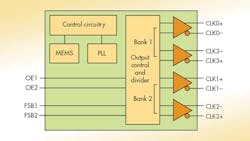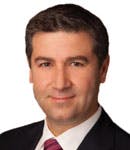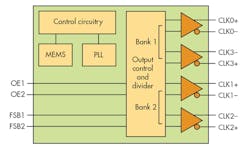Since Micrel acquired Discera last year, the company has been evangelising microelectromechanical-systems (MEMS) timing technology. But despite the many advantages MEMS has over crystal timing products, there has been limited uptake of the technology so far. Rami Kanama, vice president and general manager of Micrel’s Timing and Communications Group, discusses the MEMS timing market.
Electronic Design Europe: Previously, silicon MEMS timing products could not compete with quartz’s low jitter performance for applications such as telecommunications. Has the jitter performance of silicon MEMS improved?
Rami Kanama: For telecom and networking applications, the jitter performance needed improvement from both the MEMS and the controlling ASIC. The ASIC that Discera had was good, but we can improve it to lower the jitter produced by the PLL [phase-locked loop] and buffer. We already have proof of concepts, and it will get to the level where it will definitely compete with crystal. The resonator has to be structured to generate higher frequency, lower jitter, and higher Q, and the input from that to the ASIC has to change to differential. We already have a better design on our existing MEMS, and the ASIC is being improved right now to take advantage of that. We have simulations that show we will be at the telecom level by next year.
EDE: Micrel MEMS timing devices have configurable outputs, so the number of outputs, voltages, and frequencies can be changed. How important is the programmability of the MEMS devices?
RK: We have the same resonator with two versions of the ASIC, depending on if it’s a low-power application or higher-performance, low-jitter application, but everything else is configured after assembly through an SPI [serial peripheral interface] or I2C interface (see the figure). That allows us to provide not only samples, but production quantities to the market with very low lead times, around two weeks. The product already exists, it’s on the shelf, we configure it and test it for that application, and then ship it. For prototyping and samples we have a kit that we give to customers. It contains some “blank” parts and the software to program them.
EDE: With the many advantages MEMS timing products have, why do you think these products have not yet gained market acceptance?
RK: In general, engineers are a conservative species. They don’t want to take a chance on anything. MEMS today cannot do everything for everyone. Crystal and the quartz industry has been around for more than 80 years, so they’ve had time to improve and fine tune and do things that different applications want, and customers have gone through the pain. And they qualified multiple suppliers based on that. MEMS has only been shipping for the last five years, so it’s still relatively new compared to a 80- to 100-year-old technology.
Initially the job of evangelising this technology was done by a couple of startups. It’s a great technology, but you need a stable supplier that has financial backing and has existing relationships with their customers. The speed of adoption has gone up because now you have bigger companies supplying and you have multiple sources. The risk is not there, because it’s already multi-sourced to a crystal, so customers can still use a MEMS and a crystal as multi-source in the same socket.
EDE: What is the market like in Europe for MEMS timing devices?
RK: The biggest potential market for us in Europe is automotive. Automotive is a good growth area for us because it takes advantage of the MEMS operating temperature and shock and vibration properties. We are already in discussions with different companies, for example, in an automotive camera system for a black box/collision detection application. Our products are automotive qualified, but we need to go through the process with each customer. They have their own requirements and criteria.
Industrial is another ideal application, whether it’s smart metering or automation. The robustness of the silicon device and its inherent characteristics of those devices give us an advantage over crystal. And the operating temperature and small size is also a plus. So we’re seeing adoption of these devices not for the price, but really for the benefits MEMS brings.
EDE: When MEMS timing devices first came to the market a few years back, the technology was widely described as the future of timing since it could potentially be integrated into the same package as larger systems-on-chip (SoCs). Is the industry still working toward this level of integration?
RK: We have been talking to a lot of SoC companies. Our idea is to work with them on the ASIC portion of their design, because their chip has to have the right front-end oscillator and PLL to use MEMS. Today they have an oscillator and a PLL integrated into every chip, but it’s made to accept a crystal, and that has to be modified to accept a MEMS resonator. So once that happens, then they can take this silicon and stack it on top of their die and package it in a plastic package. They can’t do that with a crystal because you can’t sit that on top [because it requires special packaging].
Internally, within Micrel we are integrating our MEMS timing devices within our SoC solutions. That effort requires three different business groups to work together, and we have engineers dedicated in all three. You may see some news on this next year.
About the Author
Sally Ward-Foxton
Sally Ward-Foxton is Associate Editor of Electronic Design Europe. Her beat covers all areas of the European electronics industry, but she has a particular interest in wireless communications and displays technology. She was previously Features Editor of Components in Electronics magazine and has also worked as a PR Account Director. Based in London, Sally holds a Masters' Degree in Electrical and Electronic Engineering from the University of Cambridge, UK.


